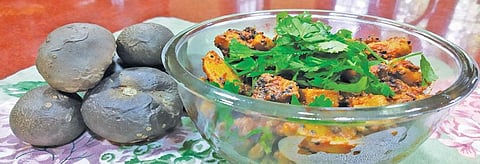

At a stall in this year’s Himanya Saras Mela, Uttarakhand’s annual festival held in Dehradun every November to promote local products, I found people buying an unusual looking tuber. One of the customers told me that it is called gaithi and is consumed in the winters for warmth. Stall owners Rakesh Joshi and his wife Kiran from Haldwani district say they are surprised with the tuber’s popularity. “We have been putting up a stall here since 2015. This is the first time we got 80 kg of gaithi. We are now left with just 20 kg,” says Joshi, adding that he is selling it for `100 a kg.
In the hills of Uttarakhand, the tuber grows wild at a height of 150 to 2,100 metres. But unlike other tubers, it is a climber that hangs in the air and is therefore commonly called air potato or yam. Dioscorea bulbifera is a species of yam family Dioscoreaceae, and is native to Africa, Asia and northern Australia. In Haldwani, every household has the climber, says Ishwari Singh Bisht, a retired plant scientist from Bhowali-based National Bureau of Plant Genetic Resources.
In early 2018, Bisht and his team published a paper highlighting its nutritive values in the Journal of Food Science and Toxicology. They found that gaithi contains higher amount of fat, protein, fibre and minerals than cultivated tubers. Every 100g of the wild tuber contains fat (0.54g), protein (3.75g), fibre (2.52g) in crude form, besides high amounts of calcium, phosphorous, iron, starch, and sodium. Traditionally, people consume it in times of food scarcity and cook it along with other vegetables. “If promoted, the vegetable can tackle malnutrition in the hills and help the locals meet daily nutrition needs with ease,” says Ajay Rastogi of Ranikhet-based non-profit Lok Chetna Manch.
Its medicinal and nutritive properties have been studied widely. It is used in folk remedy to treat conjunctivitis, diarrhoea, dysentery and other ailments. Even Uttarakhand’s indigenous tribe Raji or Van Rawats (king of forests), who inhabit forested pockets of Champawat, Pitthoragarh and Udham Singh Nagar districts, use the tuber to cure various ailments. According to a 2017 ethnobotany study of wild plants in Bageshwar district, local communities roast it in hot ash and consume it with salt to cure cold and cough. The findings were later published in the Journal of Medicinal Plants Studies. Dehradun-based homemaker Vimala Rawat recalls that as a child she saw old ladies boil it with ash.
Though loaded with nutrition, Bisht warns that overconsumption of the wild variety, which is slightly bitter and has small indents or thorny projections on its cover, is problematic. “Wild food such as these cannot replace staple food crops but they can be eaten in moderate quantities. We have not documented the indigenous knowledge of such wild foods from our ancestors. They knew how much to consume, when to consume and how to conserve them,” says Bisht. He adds that gaithi easily populate as the bulbils collected in the previous year can be used. Slowly, with growing awareness and commerce around wild foods, gaithi has made way to the local markets.
(The author documents indigenous foods and works on nutrition and health issues)
| RECIPE
Ingredients
Method Wash and boil gaithi until it becomes soft. Peel and dice it into small pieces. In a bowl add turmeric, coriander, red chilli powder and make it into a paste by adding a little water. In a cast iron wok, add two tablespoons of mustard oil and heat until it fumes. Then, add mustard seeds, sliced green chillies to the paste and cool it for two minutes on low flame. Add the diced gaithi and salt to taste. Cover it and cook for three-five minutes till the tuber is nice and tender. Let it sit in the wok for some time after switching off the flame. Garnish it with chopped coriander. Serve with chapati or rice. Gaithi in bhaang sauce Ingredients
Boil, peel and cut the tuber into small pieces. Grind the bhang seeds in water and strain the milky solution. Add salt, red chilli powder, cumin and coriander powder to the solution. In an iron wok, add 2-3 tablespoons of mustard oil. Once fuming hot, add cumin seeds or fenugreek seeds (in winters) and let them splutter. Now, pour the bhang solution in the wok and stir continuously to bring it to boil. Add the gaithi pieces in the gravy and boil it. |